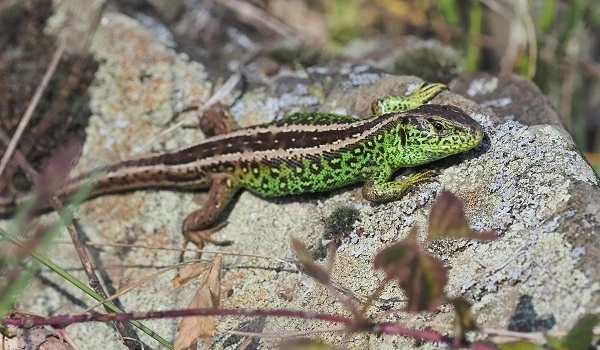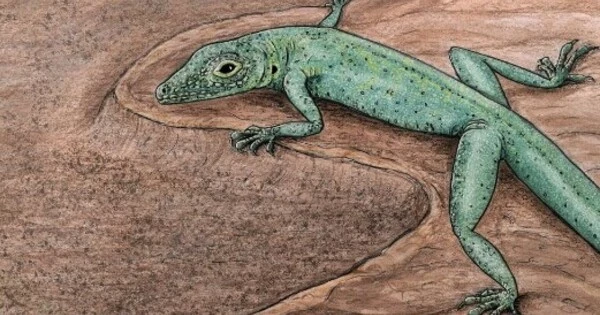The evolutionary clade and biodiversity of green lizards of the genera Lacerta and Timon – reptiles common in the Mediterranean basin and surrounding areas of the European continent, North Africa, and Asia – have never been thoroughly studied from the standpoint of historical biogeography. A new paper published in the Journal of Biogeography presents a new scenario for deciphering the potential evolutionary processes that have acted – separately or together – to give rise to the biodiversity of species in this group in Mediterranean ecosystems.
Antigoni Kaliontzopoulou of the University of Barcelona’s Faculty of Biology and the Biodiversity Research Institute (IRBio) is the study’s principal investigator. Teams from the National Museum of Natural Sciences (MNCN-CSIC), the University of Vigo and the University of Porto (Portugal), among other institutions, are also participating.
The hidden history of the evolution of green lizards
Green lizard populations are currently threatened by a variety of factors, including the destruction and fragmentation of their natural habitat, the disappearance of traditional agricultural practices, the use of pesticides, the increase in cat populations in human-populated areas, climate change, and fatal road accidents. However, despite evidence that some populations are declining, the International Union for Conservation of Nature (IUCN) has not yet designated these reptiles as endangered.
Previous research suggested that the evolution of the green lizard group was caused by a combination of evolution and ecological niche conservatism, “but the relative role of geological history and niche dynamics had not yet been tested,” says Antigoni Kaliontzopoulou, a member of the UB’s Department of Evolutionary Biology, Ecology, and Environmental Sciences.
Our findings show that higher-scale niche conservatism and rapid niche evolution played a combined role in the evolutionary history of this lizard clade around the Mediterranean.
Antigoni Kaliontzopoulou
The new research employs cutting-edge analytical tools to investigate the evolution of phenotypes and the biogeographic history of green lizard phylogeny, as well as to infer their relative contribution to species diversification. The team connects high-temporal resolution biogeographic models that integrate comprehensive data on changes in terrestrial ecosystem configuration and connectivity in the Mediterranean for the first time to assess the importance of dispersal and vicariance in determining historical range dynamics.
Specifically, the team implemented phenotypic modelling of phylogenies to identify changes in the evolutionary rate of morphological diversity and the climatic niches occupied. This information was then combined with a series of trait-dependent diversification analyses to establish how the diversification of the lineage group had been shaped.
“Such inferences usually focus on a single aspect of diversification: either cladogenesis, geographic dynamics, climatic niche properties or phenotypic trait evolution,” Kaliontzopoulou adds. “Our study is innovative in bringing together evidence that has allowed us to contrast hypotheses about different potential evolutionary processes that might act separately or in combination to shape species diversity in the Mediterranean hotspot.”

The study provides evidence that, when all existing diversity is considered, the biogeographic history of this emblematic group of Mediterranean lizards is the result of a combination of range expansions associated with dispersal events – probably dependent on geographic distance and rapid evolution of ecological niche characteristics within a specific clade.
“As a whole, the group has diversified in a relatively steady rhythm, with no changes in lineage diversification rates associated with major climatic events of the Mediterranean region, and no apparent link to functional morphological or climatic niche divergence,” says Kaliontzopolou. “Rather, the colonization of previously empty areas facilitated the diversification of new lineages through their isolation from their relatives and was aided, in some groups, by an increased tolerance to lower temperatures.”
A recurring pattern in Mediterranean ecosystems
The evolutionary history of green lizards appears to have been dominated by biogeographical episodes of long-distance dispersal into previously empty areas, modulated by the allopatric divergence process. These processes are also accompanied by the mechanism of ecological niche conservatism, which is occasionally interrupted by events of local evolution and climatic niche adaptation, but there is no evidence of a link to morphological evolution.
“Our findings show that higher-scale niche conservatism and rapid niche evolution played a combined role in the evolutionary history of this lizard clade around the Mediterranean,” says Kaliontzopolou. “
This seems to be established as a recurrent pattern in Mediterranean ecosystems, with several examples accumulating to support the idea that while niche conservatism is a common mechanism favoring the buildup of diversity, transition away from hotspots is related to events of accelerated niche evolution. Furthermore, diversification in functional morphology does not emerge as a key component of the diversification process of green lizards.”
This contrasts with other biogeographic areas where structural niche partitioning is an important process of lineage diversification, such as the tropics, which may have more stable climatic conditions.
“In Mediterranean ecosystems, it appears that lineage diversification is rather driven by geological events and allopatric divergence after colonization of new environments,” the researcher concludes. “In such environments, morphological divergence appears to occur much more recently and within already diversified groups, possibly as a response to ecological-scale events or processes such as sexual selection, which were not investigated in our study.”
















